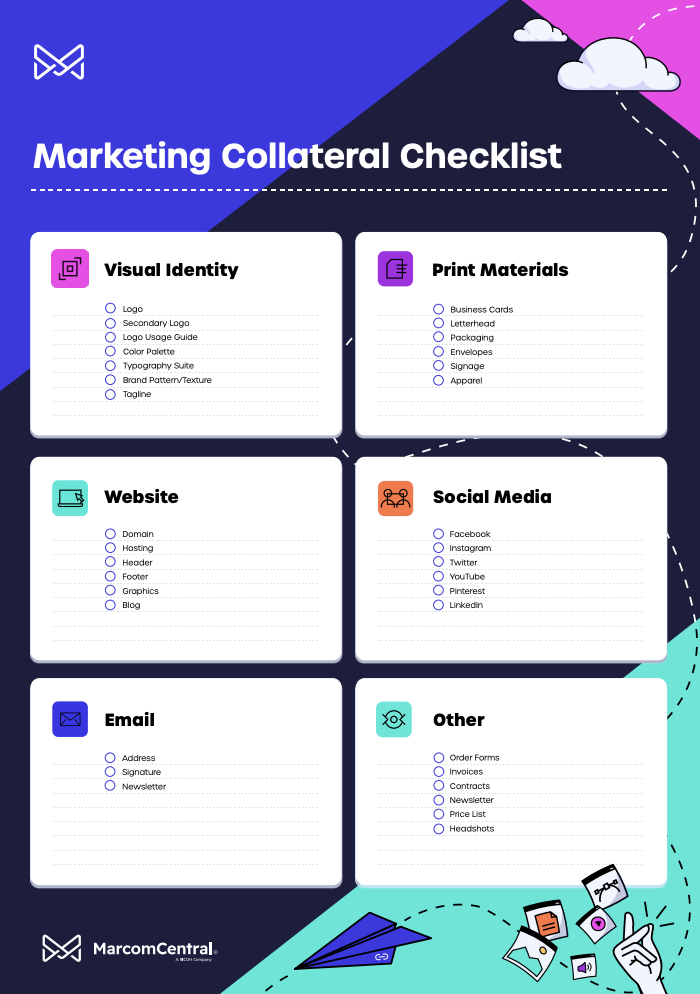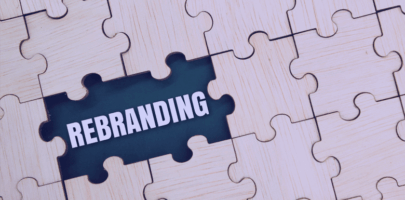- What Is Marketing Collateral?
- The Role of Marketing Collateral in Your Marketing Strategy
- Enhancing Brand Message and Recognition With Collateral
- Supporting the Buyer’s Journey: How Collateral Drives Lead Generation
- Clarifying Marketing Materials vs. Collateral
- Types of Marketing Collateral
- High-Quality Marketing Collateral Examples
- Branding and Marketing Collateral
- The Role of Collateral in Digital Marketing
- Cost Considerations for Marketing Collateral
- Aligning Marketing Collateral With the Marketing Funnel
- Maximizing the Impact of Marketing Collateral
- The Strategic Use of Marketing Collateral
Get news, updates, and insights delivered straight to your inbox.
Understanding Marketing Collateral in Brand Management & Distributed Marketing

Identifying your target audience and choosing the right channels to distribute content means you have the makings of a great marketing strategy. The next thing you need is engaging marketing collateral — but what is marketing collateral, anyway?
Marketing collateral promotes customer education while also positioning your brand as the solution for consumers’ pain points. Understanding what marketing collateral is, how to manage it, and how to distribute it effectively is critical to the long-term success of your brand. To that end, the following guide aims to unpack the question, “What is marketing collateral?” and demonstrate how you can use it (alongside cutting-edge solutions like MarcomCentral) to elevate your content marketing journey.

FREE MARKETING COLLATERAL CHECKLIST
Download our visual checklist to ensure your marketing assets are on-brand and ready to go.
Download the Free Checklist
What Is Marketing Collateral?
From a general perspective, marketing collateral refers to any in-depth, branded content or material (be it physical or digital) that you use to promote your products, services, or values. Marketing collateral helps you educate and connect with potential customers by reinforcing your brand identity and ensuring consistent messaging across all touchpoints, including social media posts, testimonials, white papers, landing pages, and in-person interactions.
Brands in both the business-to-consumer (B2C) and business-to-business (B2B) sectors rely on marketing collateral, though each group may use different types of marketing collateral. For instance, B2B sales teams may rely on infographics and case studies, which help showcase the business value of their organization’s solutions. Conversely, B2C sales teams typically use short-form and intermediate-length marketing collateral, such as business cards, product catalogs, billboards, and direct mail.
Be that as it may, the lines between B2B and B2C marketing have become blurry in recent years, with consumer-facing sales teams resorting to more sophisticated sales tactics to win over certain niches of buyers. Similarly, some B2B sales teams are connecting with stakeholders using a mix of formal and informal collateral.
Regardless of which side of the fence you operate on, the key is creating high-quality, on-brand marketing collateral and delivering it efficiently. In order to do that, you’ll need a centralized solution with asset management functionality and user-friendly distribution tools. MarcomCentral’s Brand Management Portal ensures brand consistency by centralizing the management and distribution of your marketing collateral; use it to create and disseminate content that boosts brand awareness and draws prospective customers deep into the sales funnel.
The Role of Marketing Collateral in Your Marketing Strategy
Marketing collateral is a foundational piece of a successful marketing strategy. When properly created, managed, and distributed, it aligns your sales and marketing teams while supporting the long-term growth of your brand in the following ways:
- Increasing brand recognition
- Nurturing prospects in the consideration stage
- Introducing new products
- Closing deals
- Supporting your SEO efforts
- Establishing your brand as a thought leader
While most pieces of marketing collateral include calls to action (CTAs), valuable information takes center stage, especially when creating long-form content. Prospective customers don’t want to be bombarded with page after page of sales language; they expect your digital marketing collateral to deliver real value while showcasing what makes your product or service worthwhile.
Nevertheless, effective marketing collateral is equal parts informative and eye-catching, which means your marketing collateral should also work to enhance customer engagement. Well-designed assets that speak directly to your audience’s needs can drive stronger emotional connections and increase time spent interacting with your brand. Digital and print materials alike should support the efforts of your sales and marketing teams so they can close more deals.
Creating such effective content, though, is only half the battle. The real challenge lies in managing and distributing your marketing collateral effectively, especially across large, distributed teams. That’s why you need a centralized asset management solution like MarcomCentral.
Our user-friendly platform ensures that every asset is on-brand and up-to-date, and it empowers your team to create engaging content with customizable templates and user permissions rules regarding brand guidelines. You’ll be able to control what edits each team member can make (such as setting which colors, fonts, and stylistic elements are brand-approved) and remove barriers to effective collateral distribution, all while protecting your brand’s integrity.
Enhancing Brand Message and Recognition With Collateral
You’ve poured significant time, money, and resources into building a recognizable brand; now, you must protect it with consistent, high-quality marketing collateral. Today’s customers interact with brands across multiple touchpoints, and each one shapes how people view your business. Therefore, whether you are launching a new email marketing campaign, creating a podcast, or posting on social media platforms like LinkedIn, the importance of consistency is undeniable.
If prospects observe discrepancies in your messaging, they may view your company and its products as less credible. On the other hand, delivering consistent content and high-quality experiences across every touchpoint positions your brand as legitimate and trustworthy.
Maintaining consistency, however, is easier said than done, and as your business grows and incorporates additional marketing channels into its strategy, the risk of inconsistencies increases in tandem.
MarcomCentral helps you address these concerns by centralizing all of your content. You’ll be able to store and organize any type of marketing collateral, including the following:
- Visual elements
- Webpage content
- Webinars
- Explainer videos
- Contact information and email signatures
- Sales presentation
- Sell sheets
Furthermore, MarcomCentral allows you to manage content versioning and review any proposed changes, and it includes custom templates to ensure local teams can create on-brand materials without the need for design or branding expertise. Our plug-and-play tools will allow your staff to choose from pre-approved assets, which saves time and creates better customer experiences.
MarcomCentral is completely scalable as well. Whether you need to support the needs of a large regional business or a global team, our system is up to the task. Marketing teams can update messaging globally with just a few clicks, while both sales reps and regional marketers get the tools they need to speak to the needs of their target audiences without the risk of creating off-brand content.
Supporting the Buyer’s Journey: How Collateral Drives Lead Generation
With all of the above in mind, it’s easy to believe that marketing collateral is all about your brand’s image and reputation. Those are indeed important goals associated with creating and centralizing marketing collateral, but your ultimate objective is to support the buyer journey and drive more sales.
The key, therefore, is to create different types of marketing assets for each audience segment and stage of the buyer’s journey. For instance, suppose that you are targeting individuals in the awareness stage. In such a scenario, your marketing collateral may primarily consist of things such as:
- Blog posts
- User guides
- Explainer videos
- Infographics
When new customers enter the sales funnel, you need to win them over with a strong value proposition about the specific topic they are interested in. Focus on their pain points and hint at the ways your products can solve them.
As your prospects move deeper into the funnel, you can target them with more in-depth content. Case studies, white papers, success stories, and thought leadership content are some great options when nurturing leads in the consideration stage.
At the decision stage, you must provide hard data and social proof to seal the deal. Pricing sheets and testimonials are essential to address the sensible and emotional aspects of making the purchase.
If you are marketing to B2B clients, focus on metrics that show the short and long-term value of your solution. ROI calculators and demo decks can be the tipping point you need to seal the deal.
Clarifying Marketing Materials vs. Collateral
You might assume that all of your marketing materials count as marketing collateral, but that’s not exactly the case. Marketing materials refer to all of your marketing assets, including the following:
- Blogs
- Landing pages
- Service pages
- Paid ad content
The key distinction between material and collateral is the intent and depth of the content. The latter focuses more on showing customers what you are about as opposed to outright telling them. It prioritizes education and showcases why your product offerings are better than the competition’s.
The good news is that you can simplify marketing collateral management with MarcomCentral. Our platform allows you to sort and categorize all of your marketing resources, including collateral and even general materials like blogs. You can include metadata about each type of asset so that team members understand the intended use case of each resource. You can also label each asset (i.e., collateral, materials) and add tags to help sales staff know when to use the materials (i.e., top of the funnel, new product launch).
Types of Marketing Collateral
Marketing collateral comes in many forms, all of which are designed to connect with prospects at specific points in the buyer’s journey. These assets typically fall into two overarching categories: digital and print.
Digital Marketing Collateral Explained
Digital marketing collateral comprises landing pages, email templates, social media graphics, digital brochures, infographics, and just about anything else you can distribute digitally. It is the larger and more diverse segment of marketing collateral, and its assets (which can be easily shared across multiple platforms) are ideal for scalable, fast-moving campaigns.
Over paper-based content, digital marketing collateral offers many advantages. You can track user engagement and other performance metrics to better understand what resonates with your target audience. You can also modify and disseminate digital assets at scale, which is key to supporting large, decentralized teams.
Sales teams in each region will, in turn, want to put their own twists on marketing assets. However, as they customize assets to align with the needs of each market, sales teams must also maintain brand consistency.
It is here where the flexibility of digital marketing collateral can also act as a weakness; organizations that lack visibility and a centralized digital asset management (DAM) platform will struggle to maintain brand consistency and quality standards.
Thankfully, MarcomCentral’s DAM solution solves these consistency challenges by providing a single source of truth for all of your marketing collateral. You can distribute high-quality content on a global scale without compromising your brand voice.
MarcomCentral also supports localization and versioning, which means your teams can tailor their content by region, language, or audience using pre-approved fonts, colors, and images. Altogether, the platform fosters a specific kind of flexibility that still ensures your marketing collateral is relevant and on-brand.
Your efforts with digital content have helped you build a brand that customers know and love — protect it with MarcomCentral.
Print Marketing Collateral Explained
Print marketing collateral includes tangible items, such as business cards, brochures, catalogs, signage, and direct mailers. While digital content is undeniably king these days, print marketing assets can still add value to your strategy.
For instance, distributing brochures and business cards at trade shows gives your sales reps a chance to add leads to their pipeline. Direct mailers are another great asset, as they can feel more personalized and thoughtful than an email. What’s more, direct mail collateral can be especially useful when promoting local sales and time-sensitive events.
Managing your print materials involves overcoming some of the same challenges you will encounter when disseminating digital assets, but fortunately, MarcomCentral’s DAM platform centralizes both types of assets. Your team members can make adjustments to pre-approved materials and print them on-site to create location-specific content.
High-Quality Marketing Collateral Examples
MarcomCentral has eased the challenge of managing marketing collateral. Take, for example, CoolSculpting, which used MarcomCentral to create a one-stop shop for all of its branded marketing assets. Today, our platform supports 4,300 CoolScultping employees worldwide and manages content in ten different languages.
There is also Imagine 121, which partnered with MarcomCentral to simplify its marketing collateral management. The company used our platform to scale its production of print-ready PDFs and then disseminate these assets to some of the world’s largest banks. By using our DAM solution, Imagine 121 has since generated over $1 million in revenue.
MarcomCentral doesn’t only help brands generate revenue with high-quality marketing collateral, though; it also promotes long-term cost savings. Delta Vacations, for instance, implemented MarcomCentral among 7,500 users and currently manages over 500 assets within our platform.
MarcomCentral helped Delta Vacations ensure brand consistency across all of those assets and saved the brand thousands in annual printing costs via our print-on-demand feature. Prior to implementing MarcoomCentral, the company was spending $60k annually on printing. Delta Vacations slashed these costs and reduced marketing asset-related spending discrepancies.
Branding and Marketing Collateral
Before you publish a piece of content, you need to make sure it honors your brand voice and values. Even the smallest inconsistencies can undermine your credibility and negatively impact customer trust.
Some common inconsistencies that can occur when you lack a centralized asset management solution include the following:
- Wrong colors or fonts
- Distorted or otherwise off-brand logos
- Cluttered layouts that give a different vibe compared to your usual content
- Poor content quality
- Grammatical errors
- A lack of clarity
- The wrong tone
When sales teams are given too much latitude to customize their marketing collateral, these types of mistakes become the norm. That’s why strong branding must extend to every piece of collateral.
MarcomCenral solves that challenge by giving your marketing teams full control over branding in every asset. Use our customizable templates and permission-based access to regulate changes to marketing collateral, and make sure to set up approval workflows for major changes to your marketing assets so that you can verify the content is on-brand and tonally consistent.
With MarcomCentral, you can provide your customers with a seamless, consistent experience. Every medium will deliver on-brand content while strengthening trust in your organization. No matter the format or channel, MarcomCenral empowers your marketers to scale your collateral library without compromising brand integrity.
The Role of Collateral in Digital Marketing
The digital marketing landscape is more cluttered than ever. Consumers are bombarded with ads and branded content every time they turn on their computers or open their favorite social media app. That, in turn, means you need to understand how you can stand out in such a crowded environment.
Marketing collateral holds the answer: It differentiates your brand from companies that pump out generic or pushy content because it is all about substance and value. Instead of pushing your audience to “act now,” you promote informed decision-making and trust in your brand.
Transitioning away from physical collateral to digital alternatives will also help your business be more nimble. You’ll be able to react to changes in consumer preferences and capitalize on potentially fleeting trends to grow your business. Digital collateral can be updated, tested, and distributed more efficiently than physical assets as well. However, you’ll need the right tools to create great content both quickly and on a large scale.
That’s where MarcomCentral’s custom dynamic templates come in. These empower your marketing team to create and customize digital collateral without sacrificing brand integrity. Local teams or sales reps can also use our templates, and our drag-and-drop editing tools make it easy for authorized users to customize templates using pre-approved assets.
Altogether, the centralized nature of MarcomCentral gives you the oversight necessary to protect your brand while also equipping regional sales and marketing teams with the ability to connect with local audiences.
Cost Considerations for Marketing Collateral
It’s all but a matter of fact that marketing collateral is an invaluable resource for any business. The problem, however, lies in building great assets while staying within your budget. Several factors can impact the cost of your marketing collateral, such as:
- Design complexity
- Production volume
- Format
- Distribution method
Designing both digital and print collateral requires relatively equal amounts of work, but printing physical assets can be incredibly costly. Couple in shipping physical materials, and both processes represent recurring expenses that you must account for with every campaign.
On the digital side, software licenses and digital design services represent the bulk of your costs. Once you have the right software in place, distributing assets via email and social media is budget-friendly. However, promoting digital collateral via paid ads can drive up your distribution costs.
The biggest threat to your marketing collateral budget, though, is redundancy. Outdated materials and overreliance on manual reworking can erode your budget and reduce the reach of your campaign.
Luckily, MarcomCentral helps you track and control these expenses by centralizing the entire process. Teams can access brand-approved templates and assets in one place, thereby reducing duplicated work and minimizing the risk of errors. You can distribute updated content globally, which eliminates the need to redesign materials.
Aligning Marketing Collateral With the Marketing Funnel
Marketing collateral must align with the different stages of the marketing funnel. Before creating an asset, consider which audience segment you are trying to reach and what stage of the funnel you are targeting.
Blog posts, infographics, and social media content are great for targeting consumers in the awareness stage.
Once they move to the interest and consideration stages, draw them in with white papers and product guides; these will showcase the value of your offerings and position your brand as the solution to their problems.
Sell sheets and testimonials will help your sales team close deals at the end of the funnel by giving eager buyers the information they need to choose the right product or service.
MarcomCentral makes customizing your documents efficient and simple. Our platform also includes built-in search features so your sales teams can find and distribute the right content to engage prospects effectively.
Maximizing the Impact of Marketing Collateral
The best marketing collateral includes the following:
- Clear CTAs
- A focused message
- A specific audience
- Captivating content
- Persuasive copy
The question you must ask is whether your collateral includes these characteristics and is having a positive impact on your company’s growth. MarcomCentral includes built-in analytics tools to see which materials are being used, shared, and downloaded. Use them to refine your messaging and retire underperforming content. With MarcomCentral, your team can consistently optimize its collateral and ensure every piece delivers value to your audience.
The Strategic Use of Marketing Collateral
Creating great marketing assets is the first step toward sustainable brand growth. From there, you need to equip your team with the tools to strategically deploy branded assets at scale. MarcomCentral’s brand management and distributed marketing platform is an all-in-one solution for creating, distributing, and managing high-quality collateral that supports your marketing goals. Book a demo today.


